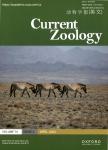Seasonal metabolic flexibility is correlated with microclimate variation in horned larks and house sparrows
作者机构:Department of BiologyUniversity of South DakotaVermillionSD 57069USA
出 版 物:《Current Zoology》 (动物学报(英文版))
年 卷 期:2022年第68卷第2期
页 面:199-210页
核心收录:
学科分类:0710[理学-生物学] 07[理学] 0713[理学-生态学]
基 金:Funding was provided by the University of South Dakota Graduate School and Department of Biology
主 题:climatic variability hypothesis Eremophila alpestris metabolic flexibility metabolic rates microclimates Passer domesticus
摘 要:Maximum and minimum metabolic rates in birds are flexible traits and such flexibility can be advantageous in variable climates.The climatic variability hypothesis(CVH)posits that more variable climates should result in greater metabolic flexibility for geographically distinct populations.Whether the CVH applies to sympatric species occupying microclimates differing in variability is unknown.Microclimates of open habitats are likely more variable than those of sheltered habitats.If the CVH extends to microclimates,we expect birds from open habitats to show greater flexibility than those from sheltered habitats.To test this extension of the CVH,we compared seasonal variation in microclimates and metabolic rates for sympatric horned larks Eremophila alpestris,which occupy open habitats,and house sparrows Passer domesticus,which occupy sheltered habitats.We measured operative temperature(T_(e′) an integrative measure of the thermal environment),summit metabolic rate(M_(sum′) maximal cold-induced metabolic rate),and basal metabolic rate(BMR,minimal maintenance metabolic rate)in summer and winter.For both winter and summer,daily minimum Te was similar between open and sheltered habitats but maximum Te was higher for open habitats.Winter microclimates,however,were colder for open than for sheltered habitats after accounting for convective differences.Both species increased M_(sum) in winter,but seasonal M_(sum) flexibility was greater for larks(43%)than for sparrows(31%).Winter increases in BMR were 92.5% and 11% for larks and sparrows,respectively,with only the former attaining statistical significance.Moreover,species*season interactions in general linear models for whole-organism metabolic rates were significant for BMR and showed a similar,although not significant,pattern for M_(sum),with greater seasonal metabolic flexibility in horned larks than in house sparrows.These results suggest that extending the CVH to sympatric bird species occupying different microclimates may be valid.



